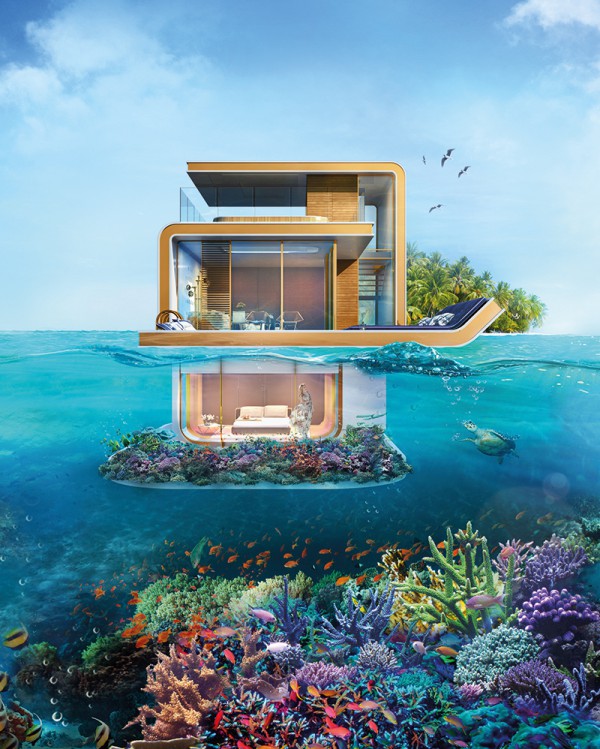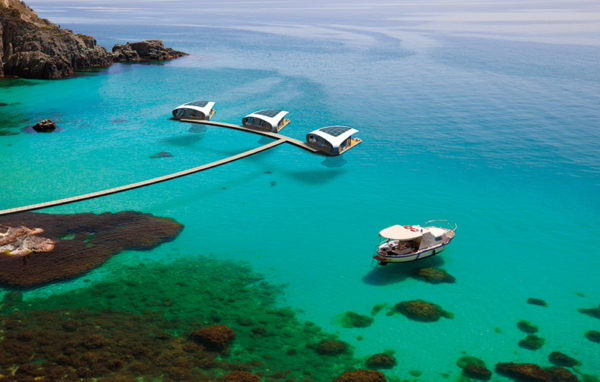Invest in These: 6 Floating Villas
Architects around the world are coming up with new ways to provide residents with that private island feel thanks to the new floating villas.

Flying over the Maldives in a prop plane, islands appear like green pebbles in a blue-green sea. From above, constellations of resorts are also visible, their villas often snaking out from the edge of the land, hugging the sides of boardwalks and perched atop wooden stilts.
Not all villas are tethered to docks, however. At some new resorts, the bungalows have been designed to float on the Indian Ocean. One such project is named The Ocean Flower and includes 185 floating villas arranged in the form of a Maldivian flower. Designed by Dutch architecture firm Waterstudio, the two level villas have three bedrooms, private plunge pools and are priced from around $2.5 million.

The Ocean Flower
“What we tried to do with our office is to take the difference between a normal house and house boat and make them the same,” says Waterstudio founder Koen Olthius. He began designing floating homes in the Netherlands, but now exports the concept to worldwide locations.
The Ocean Flower forms part of The 5 Lagoons, a master-planned resort in North Male atoll, a 20-minute boat ride from the capital of Male that is a joint venture between Dutch Docklands International and the Maldives Government. Waterstudio is also designing the Amillarah, another phase of The 5 Lagoons that will feature10 floating private islands arranged in an archipelago configuration. Each will have a private beach, pool, greenery and a jetty to moor yachts.
In the Maldives, where natural islands are small, scarce and vulnerable to tides and rising water levels, resort developers are progressively turning to floating architecture. “The concept suits [the Maldives] perfectly,” says Dymitr Malcew, a Singapore-based architect. He designed a luxurious floating home concept for a French developer in 2012 and has since received inquires from resort developers and private investors around the world, including the Maldives.

Malcew Floating Homes, Maldives
Malcew’s house concept features two bedrooms, two bathrooms, a terrace and full-height windows that provide optimal daylight and views. The home is built on a floating platform that can be easily moved and electricity is supplied via solar panels, or a network if it is docked at a marina. It also has a water purification system. “I was inspired by the automotive and luxury yacht markets rather than a typical architectural approach,” Malcew explains.
The floating house concept is not confined to the Maldives, however. In Thailand, resorts like The Float House River Kwai Resort in Kanchanaburi features floating villas made of teak wood and bamboo, each having a private balcony and pier. Thai design firm Agaligo Studio has also introduced a modern take on the floating vernacular with the X-Float, a series of floating resort villas on the River Kwai that are made from lightweight steel framing clad with fiber cement siding and plywood. The units are all oriented to maximize river views while also shielding the intense tropical sun.
Hong Kong-based consultancy BMT Asia Pacific has also created floating home concepts it likens to a ‘stationary yacht,’ designed to create novel experiences for holidaymakers. The Sea-Suite debuted in 2014 with three models – Floating Lodge, Houseboat, and Beach Cabin, each of which use an egg-shaped mold as the basis for transportable, easily adaptable and nautically minded lodging designs. The newer SeaScape edition features expansive 40-foot decks on a triangular floor plan. Each villa is customizable and can be expanded with the option to add on a variety of units, including a sun deck or covered pool, making the floating resort up to 1,800 sq. ft. in size. The design also features an underwater bedroom housed in a 13-foot diameter acrylic column that creates an aquarium effect with 360-degree views of marine life.

The Floating Seahorse
A new project in the Middle East unveiled in December also proposes an underwater bedroom. Kleindienst Group’s new development is called The Floating Seahorse and features a collection of floating villas off the coast of Dubai. The structures are designed like unpowered boats and have three levels: a submerged master bedroom and bathroom designed to offer views of the surrounding marine life, a main level with a kitchen, dining area and deck, and an upper level that has an informal bed, kitchenette and glass-bottomed Jacuzzi. Developers sold around 60 units when the first models went on sale. The remaining seahorses are priced from $2.8 million.
“We are seeing a trend worldwide, where High Net Worth Individuals are looking not only for a penthouse, but that private island feeling,” says Koen Olthius. In his home country of the Netherlands, 50 percent of the population lives below sea level, and the Dutch have spent centuries constructing dikes, pumps, and drainage systems to keep the encroaching North Sea at bay. Floating houses have provided an alternate solution – as far back as the 17th century, barges were repurposed as homes.

The Floating Seahorse, Interior
In recent years, floating structures have again grown in popularity, particularly in the face of extreme weather. The obvious advantage is that they move vertically with fluctuations in water levels caused by tides, heavy rainfall or other flooding. They are also easily relocated.
But beyond the pragmatic reasons, floating homes are also appealing to prospective residents because they afford an intimate proximity to water, and a feeling of openness, with light and views that are more akin to a boat than a house. A ‘normal’ house requires a large margin with the water level to prevent flooding. With a floating home, openings in the façade can safely be placed just 35 cm above the water level.
In the United States, floating homes are most common on the West Coast, particularly in Seattle where Lake Washington, Lake Union, and The Locks offer sheltered water edge conditions ideal for floating structures. Standing inside the floating home is an incredible feeling, says Eric Cobb, a Seattle-based architect who works on floating homes. “When you are on the first floor, you are maybe a foot off the water level and it feels like you are on a boat. It’s an amazing experience to have a sliding glass door off your bedroom and the water right there.”

SeaScape Luxury FLoating Villas Concept
In recent years floating homes in Seattle have become increasingly regulated due to their impact on the shoreline. “They are big, they create massive shaded areas and it impacts eco systems,” says Cobb. Municipal regulations now prevent the development of new floating home slips, although the resale market is thriving.
Koen Olthius at Waterstudio believes such municipal regulations reflect an “old-fashioned way of thinking” and stands in the way of allowing floating homes to proliferate into the mainstream market and create what he believes is a more sustainable housing model. “The experience we have in Holland makes us experts in how large and small foundations can be,” he says.
Many architects argue that since floating systems are adaptable and can be moved at short notice without leaving scars on the environment, this makes them a more sustainable and durable way to build. BMT’s SeaScape model, for example, is designed for offshore locations around small islands where a minimal footprint is key. The overall power load is also mitigated by the option of installing solar panels on the roof, as well as by natural ventilation. “While we haven’t specifically focused on green features in the design, a number of them are intrinsic to a waterside location — improved natural ventilation from sea breezes and temperature moderation through the hull from seawater,” says Sichard Colwill, Managing Director of BMT Asia Pacific.

Amillarah Private Islands, Dubai
The concept also provides a solution for humanitarian causes, particularly in low-lying, flood-prone regions. Luxury developers have funded much of the recent innovations to floating homes, but Olthius says a new wave of demand is coming from land-strapped and flood-prone cities from the Ukraine to China.
In the UK, design firms have proposed similar typologies as a means to deal with flood-stricken areas of the nation and as a solution to London’s housing shortage. Baca Architects recently developed a buoyant home for an NLA competition to address the capital’s housing crisis. The project aims to install prefabricated floating housing on disused space along the 50 miles of rivers and canals in Greater London, as well as the 150 hectares of additional “bluefield” space in its docklands, marinas and basins. For Koen Olthius, the transition to water homes is simply a matter of plugging them into the existing grid. The demand for floating homes is clear, he says, now it’s a matter of negotiating with municipalities and insurance companies and educating them on the long life span of water homes, and their low maintenance costs.

The Float House River Kwai Resort, Thailand
If sea levels begin to rise as predicted, municipalities may have no choice but to embrace the floating home model. For the moment, some countries are more open to the idea than others. Waterstudio has spent the past two years working on a project in Florida, but have encountered considerable resistance from the local community. “If I have an empty space of land, you understand that I can build there, but if I have a piece of water, everyone complains,” Olthius says. “In the US people have a stronger feeling of rights and of privacy compared to other parts of Europe or Asia. These homes can benefit the whole community.”
However, even if there isn’t a dramatic rise in sea levels, Olthius says he is committed to building on water. “We are concerned with urbanization, with the price of land, the need for land,” he says. “Water gives us three things: space; safety and flexibility, and a very short response time to changes we cannot foresee.”
Story Credits
This article was first published in Palace Magazine.



